
Dolichoderinae is a subfamily of ants, which includes species such as the Argentine ant, the erratic ant, the odorous house ant, and the cone ant. The subfamily presents a great diversity of species throughout the world, distributed in different biogeographic regions, from the Palearctic, Nearctic, Afrotropical region and Malaysia, to the Middle East, Australian, and Neotropical regions.
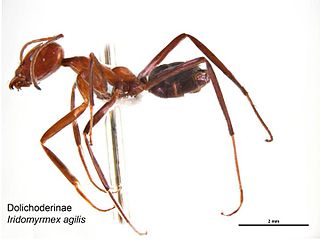
Iridomyrmex agilis is an ant of the genus Iridomyrmex. They are distributed throughout most of Australia. They are usually found in the drier regions of Australia. The species was described by Forel in 1907.
Chronoxenus butteli is an Indonesian ant of the genus Chronoxenus. It was once considered to be a part of the genus Iridomyrmex, and was moved from there to Chronoxenus. It was described by Forel in 1913.
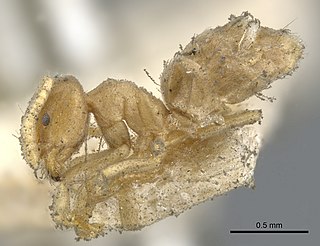
Chronoxenus myops is a species of ant of the genus Chronoxenus. It was described by Forel in 1895.
Chronoxenus rossi is a species of ant of the genus Chronoxenus. It was described by Donisthorpe in 1950.
Chronoxenus dalyi is a species of ant of the genus Chronoxenus. It was described by Forel in 1895. The ant is endemic to Bangladesh, India, Nepal and China.
Chronoxenus wroughtonii is a species of ant of the genus Chronoxenus. It was described by Forel in 1895, and was once apart of the genus Iridomyrmex. They are endemic to China, India and South Korea.
Eldermyrmex is an extinct genus of ant in the Formicidae subfamily Dolichoderinae. The genus contains a single described species Eldermyrmex oblongiceps. Eldermyrmex is known to be from the Baltic Amber.
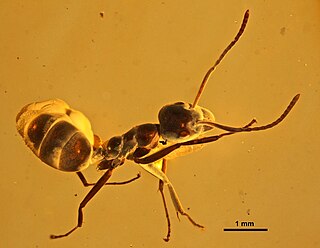
Yantaromyrmex is an extinct genus of ants first described in 2013. Members of this genus are in the subfamily Dolichoderinae of the family Formicidae, known from Middle Eocene to Early Oligocene fossils found in Europe. The genus currently contains five described species, Y. constrictus, Y. geinitzi, Y. intermedius, Y. mayrianum and Y. samlandicus. The first specimens were collected in 1868 and studied by Austrian entomologist Gustav Mayr, who originally placed the fossils in other ant genera until the fossils were reviewed and subsequently placed into their own genus. These ants are small, measuring from 4 to 6 mm in length and can be characterized by their trapezoidal shaped head-capsules and oval compound eyes that are located slightly to the rear of the capsules midpoint, with no known ocelli present.
Iridomyrmex brennani is a species of ant in the genus Iridomyrmex. Described recently in 2011, specimens were collected from Victoria, South Australia and Western Australia in the Kambalda district.
Iridomyrmex cupreus is a species of ant in the genus Iridomyrmex. Described in 2011, specimens have only been collected in Lake Eyre in South Australia.
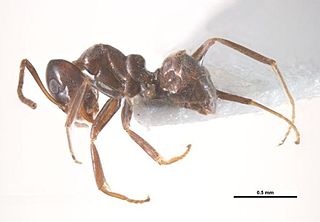
Iridomyrmex gibbus is a species of ant in the genus Iridomyrmex. Described by Heterick and Shattuck in 2011, the biology of the ant is not exactly known, although it is known that the ant is distributed in several states and in Barrow Island in Australia.
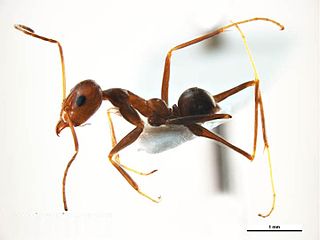
Iridomyrmex minor is a species of ant in the genus Iridomyrmex. Described by Forel in 1915, the ant is common in Western Australia, South Australia, Northern Territory and Queensland, and it is unlikely there are existing colonies in more southern Australian states. Nests have been found under bark, and is among the most likely ant to be encountered by the general public.
Iridomyrmex niger is a species of ant in the genus Iridomyrmex. Described by Heterick and Shattuck in 2011, the species is endemic to multiple states in Australia.
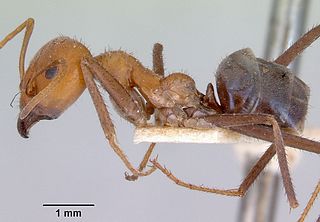
Iridomyrmex sanguineus is a species of ant in the genus Iridomyrmex. The ant is endemic to Australia and was described by Forel in 1910.

Iridomyrmex spadius is a species of ant in the genus Iridomyrmex. Described by Shattuck in 1993, localised populations of the species can be found in Queensland, Australia.
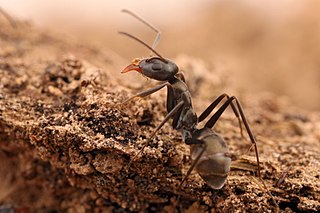
Iridomyrmex splendens is a species of ant in the genus Iridomyrmex. Described by Forel in 1907, the ant is mainly distributed in the southern regions of Australia, commonly found in dry sclerophyll woodland, and nests are found under logs.
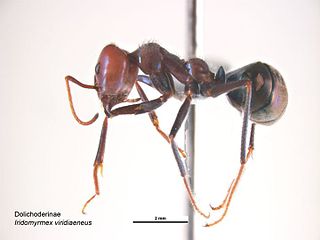
Iridomyrmex viridiaeneus is a species of ant in the genus Iridomyrmex. Described by Viehmeyer in 1914, the species is among the most widespread species in Australia of the genus.











